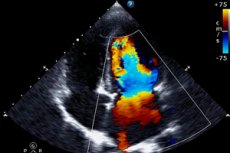Nye publikasjoner
Ultralyddiagnostikk: nye muligheter for ikke-invasiv kreftdeteksjon
Sist anmeldt: 02.07.2025

Alt iLive-innhold blir gjennomgått med medisin eller faktisk kontrollert for å sikre så mye faktuell nøyaktighet som mulig.
Vi har strenge retningslinjer for innkjøp og kun kobling til anerkjente medieområder, akademiske forskningsinstitusjoner og, når det er mulig, medisinsk peer-evaluerte studier. Merk at tallene i parenteser ([1], [2], etc.) er klikkbare koblinger til disse studiene.
Hvis du føler at noe av innholdet vårt er unøyaktig, utdatert eller ellers tvilsomt, velg det og trykk Ctrl + Enter.

Ultralydavbildning tilbyr en verdifull og ikke-invasiv måte å oppdage og overvåke kreftsvulster på. Imidlertid er invasive og skadelige biopsier vanligvis nødvendige for å få den viktigste informasjonen om kreft, som celletyper og mutasjoner. Forskerteamet har utviklet en måte å bruke ultralyd for å utvinne denne genetiske informasjonen på en mer skånsom måte.
Ved University of Alberta har et team ledet av Roger Zemp studert hvordan intens ultralyd kan frigjøre biologiske sykdomsmarkører, eller biomarkører, fra celler. Disse biomarkørene, som miRNA, mRNA, DNA eller andre genetiske mutasjoner, kan bidra til å identifisere ulike typer kreft og informere senere behandling. Zemp vil presentere dette arbeidet mandag 13. mai kl. 08.30 ET som en del av et fellesmøte mellom Acoustical Society of America og Canadian Acoustical Association, som finner sted 13.–17. mai på Shaw Centre i sentrum av Ottawa, Ontario, Canada.
«Ultralyd, på nivåer som er høyere enn de som brukes til avbildning, kan skape ørsmå porer i cellemembraner som deretter leges trygt. Denne prosessen er kjent som sonoforering. Porene som skapes ved sonoforering har tidligere blitt brukt til å levere legemidler inn i celler og vev. I vårt tilfelle er vi interessert i å frigjøre celleinnholdet for diagnostikk», forklarte Roger Zemp fra University of Alberta.
Ultralyd frigjør biomarkører fra celler inn i blodet, og øker konsentrasjonen til nivåer som er høye nok til å kunne oppdages. Denne metoden lar onkologer oppdage kreft og spore dens progresjon eller behandling uten behov for smertefulle biopsier. I stedet kan de bruke blodprøver, som er enklere å få tak i og billigere.
«Ultralyd kan øke nivåene av disse genetiske og vesikulære biomarkørene i blodprøver med mer enn 100 ganger», sa Zemp. «Vi var i stand til å oppdage paneler av tumorspesifikke mutasjoner, og nå epigenetiske mutasjoner, som ellers ikke ville blitt oppdaget i blodprøver.»
Denne tilnærmingen har ikke bare vist seg å være vellykket i å oppdage biomarkører, men er også kostnadseffektiv sammenlignet med tradisjonelle testmetoder.
«Vi fant også ut at vi kan utføre ultralydbaserte blodprøver for å se etter sirkulerende tumorceller i blodprøver med enkeltcellefølsomhet på bekostning av en COVID-test», sa Zemp. «Dette er betydelig billigere enn dagens metoder, som koster omtrent 10 000 dollar per test.»
Teamet demonstrerte også potensialet ved å bruke høyintensitets ultralyd til å flytendegjøre små volumer vev for biomarkørdeteksjon. Det flytende vevet kan ekstraheres fra blodprøver eller ved hjelp av finnålsprøyter, et mye mer komfortabelt alternativ enn den mer skadelige metoden med å bruke en nål med større diameter.
Mer tilgjengelige metoder for kreftdeteksjon vil ikke bare muliggjøre tidligere diagnose og behandling, men vil også gjøre det mulig for helsepersonell å være mer fleksible i sin tilnærming. De vil kunne avgjøre om visse behandlinger fungerer uten risikoen og kostnadene som ofte er forbundet med gjentatte biopsier.
«Vi håper at ultralydteknologien vår vil være til nytte for pasienter ved å gi klinikere en ny type molekylær analyse av celler og vev med minimalt ubehag», sa Zemp.
